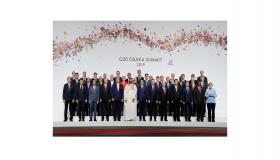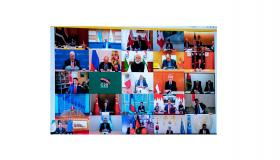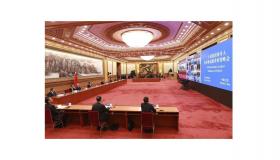
Breadcrumbs navigation
How (and why) state leaders signalled status in virtual meetings during the Covid-19 pandemic
August Danielson and Elsa Hedling discuss the key points from their new article in BISA journal Review of International Studies (RIS). The article focuses on the 26 March 2020 emergency virtual meeting of the leaders of the Group of twenty major economies (G20) to discuss the extraordinary situation facing the world. Based on a visual analysis of 51 photographs from the G20 video conference, they find that the visual performances during the extraordinary meeting reflected evident, but not necessarily intentional, attempts at status seeking.
The move to virtual meetings in the spring of 2020, caused by the extraordinary situation of a global pandemic, has resulted in the adaptation of new practices and codes of conduct in essentially all professional fields. As many of us have experienced first-hand during this time, virtual interaction opens for new ways of communicating, but it also constrains our normal habits. This is also true in the context of summit diplomacy, known to be highly symbolic occasions during which state leaders meet and display their commitment to and participation in multilateralism. These are moments in which routines of interaction matter to relations between states and when being seen to interact according to a protocol sends clear signals to observers of world politics.
In the context of international diplomacy, visual performances of a nation and its leader help shape the intersubjective reality of a state’s status in the world– in other words, whether we perceive a state to be ‘strong’, ‘weak’, ‘rich’ or ‘poor’, and so on. By framing what is thinkable and doable, such visual representations therefore help construct states’ diplomatic status in the international system. In this sense, how a state is visually represented and how such representation is performed, matters not just because it can have a causal impact on diplomatic outcomes, but particularly because it helps determine what a state can do in relation to its positioning among other states.
Previous research on summit diplomacy has also detailed the vital role that status plays when state leaders interact in front of observers (Melissen 2003; Naylor 2019). While the drama surrounding “Sofagate” is one of many contemporary examples of how status concerns can often trump the importance of the political negotiations during summit meetings, it is not a new phenomenon. An early instance of the use of visual cues to signal status was seen at the Potsdam Conference in 1945, where additional doors were added to the summit meeting room in order for the Big Three (Truman, Churchill and Stalin) to be able to enter the room simultaneously, thereby signalling equal status. The will to “be seen” in line with the protocol of summit diplomacy is thus, we argue, inherently linked with one’s ambition to increase or uphold their status in world politics. In our RIS article, we therefore study how state leaders signalled status during one of the first high profile virtual summits between the Group of 20 major economies (G20) on March 26, 2020.
A new opportunity for visual diplomacy
G20 summits, like many other multilateral summits, are normally visually performed through a strict diplomatic protocol that allows for minimal national attributes but instead places focus on the common ground. The resort to virtual summitry therefore placed world leaders in unusual visual frames. Instead of the usual “family photograph” of leaders lining up on a stage (see Figure 1), the summit was communicated to the world through the multiple gallery views of video conference tools, disrupting the visual coherency. In the following months of 2020, similar photographs of virtual meetings appeared in news media, communicating to the world that high diplomacy was carrying on in a business-as-usual fashion (Naylor 2020; Eggeling & Adler-Nissen 2021). But the photographs still reflected disruption in the new normal. Virtual summitry provided a stark visual contrast to the traditional staging of modern multilateral diplomacy―leaders were suddenly responsible for their own visual staging, leaving them with new opportunities to create a favourable impression of how they, and their respective state, would be seen.

Figure 1. G20 Summit in Osaka, Japan 2019 Source: Kim Kyung-Hoon/ Reuters

Figure 2. Virtual G20 summit 26 March 2020 Source: EPA
The above photographs, depicting two G20 summits, illustrate how virtual summitry disrupted the visual coherence and suggest an abandoned etiquette and lost sense of control of the (visual) order. Most notably, the virtual frame created new opportunities to project national attributes and, as we argue in our article, signal status. Taking this stark visual contrast as a point of departure, our study seeks to explore the visual diplomacy in virtual summitry to learn more about the disruptive effects of the pandemic, the role of visual signals and how visual performances contribute to uphold status distinctions in multilateral diplomacy. By analysing these visual performances, the article also contributes to a more fine-grained understanding of the resources, symbols and signals that are perceived to have social value in multilateral diplomacy in general, and in the context of summits in particular.
Visual signals and social interaction
We depart from the popularly phrased “visual turn” in international relations that posits that we live in an age in which images shape politics by framing what is thinkable and doable (Bleiker 2018). When photographs of state leaders are circulated to broad audiences, for instance, they frame how we think of performances such as high-profile gatherings or official ceremonies, and, in effect, how we expect leaders to behave. As often illustrated by the former US president Donald Trump, challenging such social conventions attracts attention. In the context of summit diplomacy, performances such as ceremonial arrivals and high-profile handshakes can therefore be seen as both symbolic interactions and staged ‘visual spectacles’ of expected behaviour (Constantinou 2018; Neumann 2020).
To study how visual signals correspond to social routines, we build on previous scholarship on visual diplomacy and engage with the symbolic interactionism of Erving Goffman to consider the ways in which visual performances during summit diplomacy contribute to uphold an interaction order of status seeking. For Goffman, all interactions are opportunities for actors to present themselves in ways that will have social value in the given situation. Interaction thus creates the order according to which others will interpret your behaviour and hence your status. Using Goffman’s concepts of ‘interaction orders’ and ‘performances’, which are assisted by ‘staging’ and ‘sign vehicles’, we suggest that the interaction order of summit diplomacy is (visually) upheld through status signalling.
Status signals during virtual meetings
We identify status signalling through the attributes that should be perceived as having social value within this social context and that we know from the literature on summit diplomacy, diplomatic signalling and status in world politics. We agree that status resources are historically contingent and socially defined (Pouliot 2016), and therefore that such attributes should be recognizable in a highly institutionalized context such as summit diplomacy. We limit our focus to four status resources or attributes that we argue should be regarded as having high social value in the context of summit meetings, namely: reliability, trustworthiness, material capabilities and continuity. Our visual analysis goes on to interpret how these status resources are signalled in a staged diplomatic situation such as the virtual summit (Cohen 1987). We therefore conduct the analysis through a categorization of the dominant discursive elements of a diplomatic theatrical staging: backdrop, actors, venue and props. These stage elements allow us to analyse how images are given meaning when constructing a ‘diplomatic stage’ in the virtual summit.
Staging virtual summitry
Our study was conducted through a visual analysis of 51 photographs that depict of the G20 meeting from as many angles as possible, including the video conference view (the view that the other participants would have seen during the meeting), the gallery view (the screen picturing the multiple participants) and the backstage view shared by the participants press teams. Our visual analysis was inspired by the critical visual methodology of Gillian Rose, with particular attention to visual semiotics and discourse.
In our analysis, we first return to our initial observation – the variation in backdrop staging among the participants. While at least one flag was placed behind every participating leader in order to indicate which state they represented, there was a significant variation in how many flags were presented, their position in relation to each other as well as how ‘noticeable’ they were (see figure 2). For instance, while states such as India and Indonesia chose to place as many as ten flags behind their leader, the majority of states only presented a single flag. In the article, we discuss different interpretations of the decision to place a large number of flags behind a leader, such as it being a signal of the relative importance of the nation and its national interests over the common or ‘international’ interest.
Our second stage element, the actors pictured in the photographs, also resulted in an observed variation. Some states, such as Russia, France, Canada, Japan and South Korea, chose to display their leader sitting alone, while other states included entire teams of advisors. The presence of a large number of advisors in the visual presentation of the state and its leader could be interpreted as a way to signal status, specifically by demonstrating reliability and material (economic) capabilities. In contrast to the signal that a leader sitting alone might send, a large number of advisors could be interpreted as a credible capacity to act competently – the more advisors in the room, the more likely it is that the leader will be perceived as taking well-grounded, competent decisions. A large number of participating advisors can also be seen as symbolic of material capabilities, as it signals that the state has a large administrative capacity. For instance, the United States chose to place four officials next to Trump, including Mark A Milley (the highest-ranking General in the US Armed Forces). The choice of including Milley in the US delegation was particularly interesting in this context, as no other state chose to have a military officer present at the meeting – a fairly clear signal of the vast military superiority of the United States. However, a large number of advisors could also adversely affect how others perceive a leader’s trustworthiness. In this sense, the decision regarding how many actors that should be present in the visual presentation of the state and its leader could potentially be seen as a trade-off between acquiring status either through reliability and material capabilities, or through trust.
The venues from which the leaders participated in the virtual meeting also varied. While some leaders chose to sit in relatively small, unembellished conference rooms, Xi Jinping was placed in front of a massive traditional painting in the East Hall of the Great Hall of the People in Beijing (see figure 3). The decision to show off the East Hall was in our view a clear signal of material capabilities and continuity – a large, grandiose room symbolizes wealth and prestige, while the traditional artwork indicates that China has a long and rich history. Similarly, Emmanuel Macron chose to participate in the video conference from the Green Salon in the Elysée Palace (remarkably ornate, with lavish decorations and furniture in the Baroque style), the official residence of the French president.

Figure 3: Photograph of Xi Jinping and his advisors during the virtual G20 meeting Source: XNA
Finally, we analysed the visibility of props that assisted the visual performances during the virtual summit. We identified and discuss three examples of the symbolic use of props during the virtual G20 meeting: the choice, of different coloured neckties among most of the participating leaders; the decision to place hand sanitiser next to President Macron; and the decision to place the Quran in front of King Salman of Saudi Arabia.
Our article concludes that the absence of the protocol and routines that normally guide states’ participation during summit meetings generated new opportunities for states to manifest their status ambitions and self-perceptions through visual diplomacy. While we agree that these visual performances could be argued to manifest conformity and lack of imagination, they were still breaking norms in the context of the otherwise visually controlled summit etiquette. The participants’ attempts to restore, or challenge the interaction order (by increasing one’s status), reflected the perceptions of social value in virtual summitry, which we argue is summed up by the categories of reliability, trustworthiness, material capabilities and continuity. In this sense, the variation across the staged performances confirmed the role of visual diplomacy as a social practice in virtual summitry and stresses the need of understanding why states and state leaders seemingly have a near instinctive need to pursue status as well as seek to uphold a stable sense of Self – especially in times of crisis.
Want to know more? You can read the full article at DOI: https://doi.org/10.1017/S0260210521000607
BISA members receive access to all content from RIS (and to our other journal European Journal of International Security) as a benefit of membership. To gain access, log in to your BISA account and scroll down to the 'Membership benefits' section. If you're not yet a member join today.

